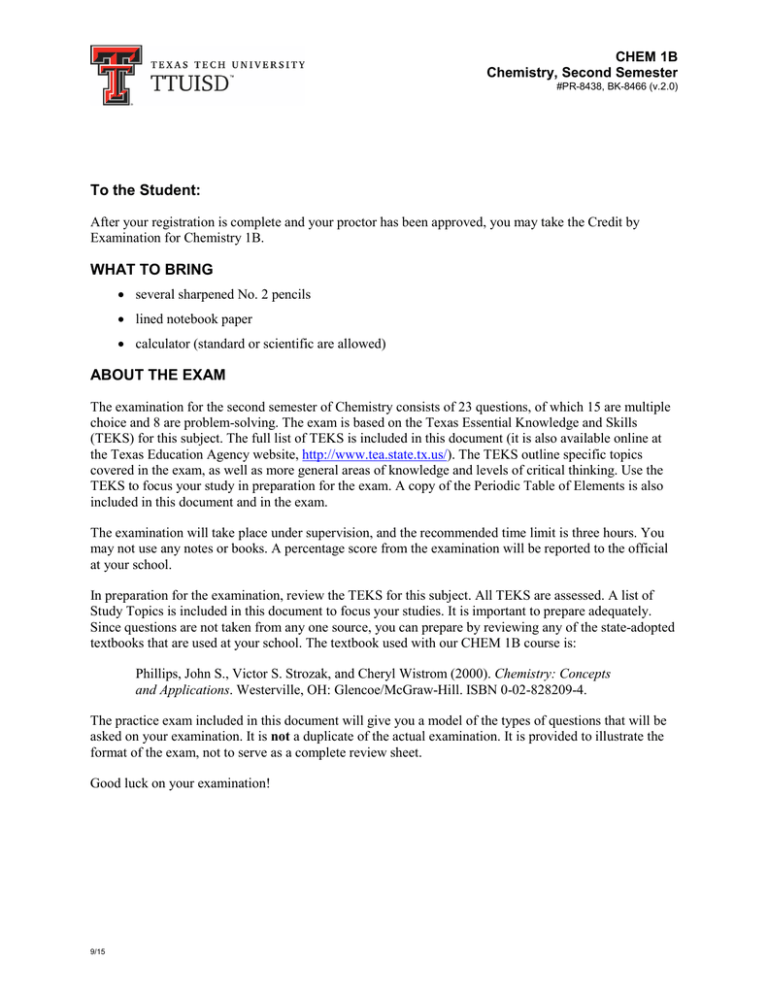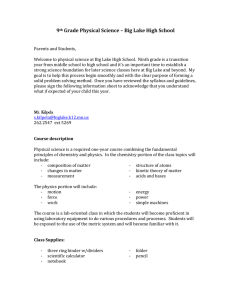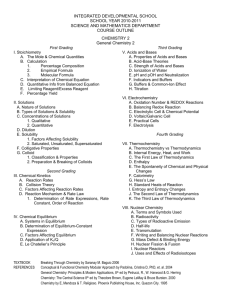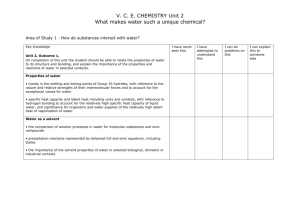To the Student:
advertisement

CHEM 1B Chemistry, Second Semester #PR-8438, BK-8466 (v.2.0) To the Student: After your registration is complete and your proctor has been approved, you may take the Credit by Examination for Chemistry 1B. WHAT TO BRING • several sharpened No. 2 pencils • lined notebook paper • calculator (standard or scientific are allowed) ABOUT THE EXAM The examination for the second semester of Chemistry consists of 23 questions, of which 15 are multiple choice and 8 are problem-solving. The exam is based on the Texas Essential Knowledge and Skills (TEKS) for this subject. The full list of TEKS is included in this document (it is also available online at the Texas Education Agency website, http://www.tea.state.tx.us/). The TEKS outline specific topics covered in the exam, as well as more general areas of knowledge and levels of critical thinking. Use the TEKS to focus your study in preparation for the exam. A copy of the Periodic Table of Elements is also included in this document and in the exam. The examination will take place under supervision, and the recommended time limit is three hours. You may not use any notes or books. A percentage score from the examination will be reported to the official at your school. In preparation for the examination, review the TEKS for this subject. All TEKS are assessed. A list of Study Topics is included in this document to focus your studies. It is important to prepare adequately. Since questions are not taken from any one source, you can prepare by reviewing any of the state-adopted textbooks that are used at your school. The textbook used with our CHEM 1B course is: Phillips, John S., Victor S. Strozak, and Cheryl Wistrom (2000). Chemistry: Concepts and Applications. Westerville, OH: Glencoe/McGraw-Hill. ISBN 0-02-828209-4. The practice exam included in this document will give you a model of the types of questions that will be asked on your examination. It is not a duplicate of the actual examination. It is provided to illustrate the format of the exam, not to serve as a complete review sheet. Good luck on your examination! 9/15 CHEM 1B Study Topics To successfully complete the CBE, you should study and understand the following topics: • Compare and contrast the mole as a number and the mole as a mass. • Relate counting particles to weighing samples of substances. • Solve stoichiometric problems using molar mass. • Predict quantities of reactants and products in chemical reactions. • Determine mole ratios from formulas for compounds. • Identify formulas of compounds by using mass ratios. • Demonstrate the uniqueness of water as a chemical substance. • Model the three-dimensional geometry of a water molecule. • Relate the physical properties of water to the molecular model. • Compare and contrast the ability of water to dissolve ionic and covalent compounds. • Distinguish solutions from colloids. • Compare and contrast colligative properties. • Distinguish acids from bases by their properties. • Relate acids and bases to their reactions in water. • Evaluate the central role of water in the chemistry of acids and bases. • Relate different electrical conductivities of acidic and basic solutions to their degree of dissociation or ionization. • Distinguish strong and weak acids or bases by their degree of dissociation or ionization. • Compare and contrast the composition of strong and weak solutions of acids or bases. • Relate ph to the strengths of acids and bases. • Analyze the characteristics of an oxidation-reduction reaction. • Distinguish between oxidation reactions and reduction reactions by definition. • Identify the substances that are oxidized and those that are reduced in a redox reaction. • Distinguish oxidizing and reducing agents in redox reactions. • Analyze common redox processes to identify the oxidizing and reducing agents. • Identify some redox reactions that take place in living cells. • Explain how a non-spontaneous redox reaction can be driven forward during electrolysis. • Relate the movement of charge through an electrolytic cell to the chemical reactions that occur. • Apply the principles of electrolysis to its applications such as chemical synthesis, refining, plating, and cleaning. 2 • Relate the construction of a galvanic cell to how it functions to produce a voltage and an electrical current. • Trace the movement of electrons in a galvanic cell. • Relate chemistry in a redox reaction to separate reactions occurring at electrodes in a galvanic cell. • Write and interpret structural formulas of linear, branched, and cyclic alkanes, alkenes, and alkynes. • Distinguish among isomers of a given hydrocarbon. • Infer the relationship between fossil fuels and organic chemicals. • Compare and contrast the structures of the major classes of substituted hydrocarbons. • Summarize properties and uses of each class of substituted hydrocarbons. • Identify monomers that form specific polymers. • Draw structural formulas for polymers made from given monomers. • Differentiate between condensation and addition polymerization reactions. • Summarize the relationship between structure and properties of polymers. • Compare and contrast the structures and functions of proteins, carbohydrates, lipids, and nucleic acids. • Analyze the relationship between the three-dimensional shape of a protein and its function. • Distinguish between the reactions that cells use in the presence and in the absence of oxygen to extract energy from fuel molecules. • Explain how a small number of biochemical building blocks can be used to make the extraordinary variety of molecules needed to perform life’s chemical functions. • Compare and contrast exothermic and endothermic chemical reactions. • Analyze the energetics of typical chemical reactions. • Illustrate the meaning of entropy and track its role in various processes. • Sequence the technique of calorimetry and illustrate its use. • Compare the heat generated by some common fuels and by some foods. • Analyze the efficiency of industrial processes and the need to conserve resources. • Analyze the process and importance of photosynthesis. • Compare the energy efficiency of photosynthesis and processes that produce electricity. • Trace how energy from the sun passes through a food web. • Analyze common sources of background radiation. • Compare and contrast alpha, beta, and gamma radiation. • Apply the concept of half-life of a radioactive element. • Compare and contrast nuclear fission and nuclear fusion. 3 • Demonstrate equations that represent the changes that occur during radioactive decay. • Trace the operation and structure of a fission reactor. • Distinguish the biological effects of radiation and the units used to measure levels of exposure. • Illustrate medical and non-medical uses for radioactivity. 4 CHEM 1B Practice Exam While not a review in itself, this sample exam will provide a brief illustration of the types of questions that will be present on the final. The practice exam consists of 15 objective questions and 5 short answer/calculation questions. Check your answers with the answer key provided. Multiple Choice 1. 44.0 grams is __________ for CO2. A. B. C. D. formula mass molar mass molecular mass atomic mass 2. Intermolecular attractions in water are particularly strong due to these characteristics of water molecules: A. B. C. D. nonpolar bonding and linear geometry. ionic bonding and bent geometry. polar bonding and bent geometry. double covalent bonding and tetrahedral geometry. 3. Certain colored dyes called __________ change color when they react with acids and bases. A. B. C. D. acid anhydrides basic anhydrides carbohydrates indicators 4. Water molecules do not react chemically with Ca(OH)2 to form a basic solution. A. True B. False 5. In the overall equation HCl (aq) +NH3 (aq) → NH4Cl (aq), what are the spectator ions? A. B. C. D. HCl NH3 NH4+ Cl– 6. When a 1 M solution of HCl is titrated with a 1 M solution of NaOH, what will happen to the conductivity of the resulting solution? A. B. C. D. It will decrease It will increase. It will remain the same. There will be no conductivity. 5 7. In the equation H2O2 (aq) + PbS (s) → PbSO4 (s) + H2O (l), what is the reducing agent? A. B. C. D. H2O2 PbS PbSO4 H2O 8. In an external circuit of an electrochemical cell, electrons flow A. B. C. D. only through the salt bridge. from anode to cathode. from cathode to anode. from right to left. 9. The lead-acid storage battery in an automobile must provide 12 volts. The battery consists of six cells. What is the potential difference for each cell? A. B. C. D. 1.5 volts 2 volts 6 volts 9 volts 10. Choose the correctly named compound. A. B. C. D. CH3CHCBrCl; 1-bromo-1-chloropropane CH2CHCHCHCHCHCH2CH3; 1,3,5-octatriene CH3CH2OH; propanol C9H20; octane 11. What is a peptide bond? A. B. C. D. an amide group an amino group an alcohol group a cross-linkage 12. What makes a reaction endothermic? A. B. C. D. the release of heat the net absorption of heat the need for heat to start the reaction an increase in disorder 13. The use of a catalyst will decrease the overall heat of a reaction. A. True B. False continued → 6 14. The radioactive isotope carbon-14 decays to form nitrogen through A. B. C. D. alpha decay. beta decay. nuclear fission reaction. nuclear fusion reaction. 15. Which word equation generally describes a nuclear fusion reaction? A. B. C. D. hydrogen-2 plus hydrogen-2 yields hydrogen-4 hydrogen-2 plus hydrogen-2 yields helium-4 hydrogen-1 plus hydrogen-1 yields hydrogen-2 hydrogen-1 plus hydrogen-1 yields helium-2 Short Answer/Calculation 16. What mass of nitrogen dioxide is formed when 21 g of Nitrogen reacts with oxygen? 17. Calculate the formula mass of barium phosphate, Ba3 (PO4)2. 18. Determine the volume of nitrogen dioxide produced by 1.5 L of Nitrogen gas. 19. What mass of potassium permanganate KMnO4 must be dissolved to make 2.0 L of 0.750 M solution of potassium permanganate. 20. What is the molar mass of sucrose, C12H22O11? 7 CHEM 1B Practice Exam Answer Key Multiple Choice 1. B 6. C 11. A 2. C 7. B 12. B 3. D 8. B 13. B 4. A 9. B 14. B 5. D 10. B 15. B Short Answer/Calculation 16. N2 + 202 → 2N02 (21g/(2)(14g/m)) = X/(2)(46g/m) X = 69 g NQ2 17. Ba = 3 × 137.3 = 411.9 P = 2 × 31.0 = O = 8 × 16 = 62.0 128.0 601.9 18. N2 + 2O2 → 2NO2 1.5 L/1m = X/2m X = 3L 19. K = 39.1 × 1 = 39.1 Mn = 101.1 × 1 = 101.1 O = 16.0 × 4 = 64.0 204.2g/m (2 L)(204.2g/m)(0.750m/L) =306.3 g 20. C = 12 × 12.0 = 144 H = 22 × 1.0 = 22 O = 11 × 16.0 = 176 342 8 Texas Essential Knowledge and Skills CHEM 1 – Chemistry §112.35. Chemistry, Beginning with School Year 2010-2011 (One Credit). (a) General requirements. Students shall be awarded one credit for successful completion of this course. Required prerequisites: one unit of high school science and Algebra I. Suggested prerequisite: completion of or concurrent enrollment in a second year of math. This course is recommended for students in Grade 10, 11, or 12. (b) Introduction. (1) Chemistry. In Chemistry, students conduct laboratory and field investigations, use scientific methods during investigations, and make informed decisions using critical thinking and scientific problem solving. Students study a variety of topics that include characteristics of matter, use of the Periodic Table, development of atomic theory and chemical bonding, chemical stoichiometry, gas laws, solution chemistry, thermochemistry, and nuclear chemistry. Students will investigate how chemistry is an integral part of our daily lives. (2) Nature of Science. Science, as defined by the National Academy of Sciences, is the "use of evidence to construct testable explanations and predictions of natural phenomena, as well as the knowledge generated through this process." This vast body of changing and increasing knowledge is described by physical, mathematical, and conceptual models. Students should know that some questions are outside the realm of science because they deal with phenomena that are not scientifically testable. (3) Scientific inquiry. Scientific inquiry is the planned and deliberate investigation of the natural world. Scientific methods of investigation can be experimental, descriptive, or comparative. The method chosen should be appropriate to the question being asked. (4) Science and social ethics. Scientific decision making is a way of answering questions about the natural world. Students should be able to distinguish between scientific decision-making methods and ethical and social decisions that involve the application of scientific information. (5) Scientific systems. A system is a collection of cycles, structures, and processes that interact. All systems have basic properties that can be described in terms of space, time, energy, and matter. Change and constancy occur in systems as patterns and can be observed, measured, and modeled. These patterns help to make predictions that can be scientifically tested. Students should analyze a system in terms of its components and how these components relate to each other, to the whole, and to the external environment. (c) Knowledge and skills. (1) Scientific processes. The student, for at least 40% of instructional time, conducts laboratory and field investigations using safe, environmentally appropriate, and ethical practices. The student is expected to: (A) demonstrate safe practices during laboratory and field investigations, including the appropriate use of safety showers, eyewash fountains, safety goggles, and fire extinguishers; (B) know specific hazards of chemical substances such as flammability, corrosiveness, and radioactivity as summarized on the Material Safety Data Sheets (MSDS); and (C) demonstrate an understanding of the use and conservation of resources and the proper disposal or recycling of materials. (2) Scientific processes. The student uses scientific methods to solve investigative questions. The student is expected to: (A) know the definition of science and understand that it has limitations, as specified in subsection (b)(2) of this section; (B) know that scientific hypotheses are tentative and testable statements that must be capable of being supported or not supported by observational evidence. Hypotheses of durable explanatory power which have been tested over a wide variety of conditions are incorporated into theories; (C) know that scientific theories are based on natural and physical phenomena and are capable of being tested by multiple independent researchers. Unlike hypotheses, scientific theories are well-established and highly-reliable explanations, but may be subject to change as new areas of science and new technologies are developed; (D) distinguish between scientific hypotheses and scientific theories; (E) plan and implement investigative procedures, including asking questions, formulating testable hypotheses, and selecting equipment and technology, including graphing calculators, computers and probes, sufficient scientific glassware such as beakers, Erlenmeyer flasks, pipettes, graduated cylinders, volumetric flasks, safety goggles, and burettes, electronic balances, and an adequate supply of consumable chemicals; (F) collect data and make measurements with accuracy and precision; (G) express and manipulate chemical quantities using scientific conventions and mathematical procedures, including dimensional analysis, scientific notation, and significant figures; (H) organize, analyze, evaluate, make inferences, and predict trends from data; and (I) communicate valid conclusions supported by the data through methods such as lab reports, labeled drawings, graphs, journals, summaries, oral reports, and technology-based reports. (3) Scientific processes. The student uses critical thinking, scientific reasoning, and problem solving to make informed decisions within and outside the classroom. The student is expected to: 9 (A) in all fields of science, analyze, evaluate, and critique scientific explanations by using empirical evidence, logical reasoning, and experimental and observational testing, including examining all sides of scientific evidence of those scientific explanations, so as to encourage critical thinking by the student; (B) communicate and apply scientific information extracted from various sources such as current events, news reports, published journal articles, and marketing materials; (C) draw inferences based on data related to promotional materials for products and services; (D) evaluate the impact of research on scientific thought, society, and the environment; (E) describe the connection between chemistry and future careers; and (F) research and describe the history of chemistry and contributions of scientists. (4) Science concepts. The student knows the characteristics of matter and can analyze the relationships between chemical and physical changes and properties. The student is expected to: (A) differentiate between physical and chemical changes and properties; (B) identify extensive and intensive properties; (C) compare solids, liquids, and gases in terms of compressibility, structure, shape, and volume; and (D) classify matter as pure substances or mixtures through investigation of their properties. (5) Science concepts. The student understands the historical development of the Periodic Table and can apply its predictive power. The student is expected to: (A) explain the use of chemical and physical properties in the historical development of the Periodic Table; (B) use the Periodic Table to identify and explain the properties of chemical families, including alkali metals, alkaline earth metals, halogens, noble gases, and transition metals; and (C) use the Periodic Table to identify and explain periodic trends, including atomic and ionic radii, electronegativity, and ionization energy. (6) Science concepts. The student knows and understands the historical development of atomic theory. The student is expected to: (A) understand the experimental design and conclusions used in the development of modern atomic theory, including Dalton's Postulates, Thomson's discovery of electron properties, Rutherford's nuclear atom, and Bohr's nuclear atom; (B) understand the electromagnetic spectrum and the mathematical relationships between energy, frequency, and wavelength of light; (C) calculate the wavelength, frequency, and energy of light using Planck's constant and the speed of light; (D) use isotopic composition to calculate average atomic mass of an element; and (E) express the arrangement of electrons in atoms through electron configurations and Lewis valence electron dot structures. (7) Science concepts. The student knows how atoms form ionic, metallic, and covalent bonds. The student is expected to: (A) name ionic compounds containing main group or transition metals, covalent compounds, acids, and bases, using International Union of Pure and Applied Chemistry (IUPAC) nomenclature rules; (B) write the chemical formulas of common polyatomic ions, ionic compounds containing main group or transition metals, covalent compounds, acids, and bases; (C) construct electron dot formulas to illustrate ionic and covalent bonds; (D) describe the nature of metallic bonding and apply the theory to explain metallic properties such as thermal and electrical conductivity, malleability, and ductility; and (E) predict molecular structure for molecules with linear, trigonal planar, or tetrahedral electron pair geometries using Valence Shell Electron Pair Repulsion (VSEPR) theory. (8) Science concepts. The student can quantify the changes that occur during chemical reactions. The student is expected to: (A) define and use the concept of a mole; (B) use the mole concept to calculate the number of atoms, ions, or molecules in a sample of material; (C) calculate percent composition and empirical and molecular formulas; (D) use the law of conservation of mass to write and balance chemical equations; and (E) perform stoichiometric calculations, including determination of mass relationships between reactants and products, calculation of limiting reagents, and percent yield. (9) Science concepts. The student understands the principles of ideal gas behavior, kinetic molecular theory, and the conditions that influence the behavior of gases. The student is expected to: 10 (A) describe and calculate the relations between volume, pressure, number of moles, and temperature for an ideal gas as described by Boyle's law, Charles' law, Avogadro's law, Dalton's law of partial pressure, and the ideal gas law; (B) perform stoichiometric calculations, including determination of mass and volume relationships between reactants and products for reactions involving gases; and (C) describe the postulates of kinetic molecular theory. (10) Science concepts. The student understands and can apply the factors that influence the behavior of solutions. The student is expected to: (A) describe the unique role of water in chemical and biological systems; (B) develop and use general rules regarding solubility through investigations with aqueous solutions; (C) calculate the concentration of solutions in units of molarity; (D) use molarity to calculate the dilutions of solutions; (E) distinguish between types of solutions such as electrolytes and nonelectrolytes and unsaturated, saturated, and supersaturated solutions; (F) investigate factors that influence solubilities and rates of dissolution such as temperature, agitation, and surface area; (G) define acids and bases and distinguish between Arrhenius and Bronsted-Lowry definitions and predict products in acid base reactions that form water; (H) understand and differentiate among acid-base reactions, precipitation reactions, and oxidation-reduction reactions; (I) define pH and use the hydrogen or hydroxide ion concentrations to calculate the pH of a solution; and (J) distinguish between degrees of dissociation for strong and weak acids and bases. (11) Science concepts. The student understands the energy changes that occur in chemical reactions. The student is expected to: (A) understand energy and its forms, including kinetic, potential, chemical, and thermal energies; (B) understand the law of conservation of energy and the processes of heat transfer; (C) use thermochemical equations to calculate energy changes that occur in chemical reactions and classify reactions as exothermic or endothermic; (D) perform calculations involving heat, mass, temperature change, and specific heat; and (E) use calorimetry to calculate the heat of a chemical process. (12) Science concepts. The student understands the basic processes of nuclear chemistry. The student is expected to: (A) describe the characteristics of alpha, beta, and gamma radiation; (B) describe radioactive decay process in terms of balanced nuclear equations; and (C) compare fission and fusion reactions. Source: The provisions of this §112.35 adopted to be effective August 4, 2009, 34 TexReg 5063. 11 12






